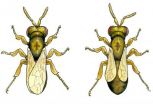(Press-News.org) Scientists have discovered a new target in their fight against the devastating global disease 'malaria' thanks to the discovery of a new protein involved in the parasite's life cycle.
The research has uncovered a vital player in the sexual phase of the malaria parasite's reproduction which could prove an effective target for new treatments to stop the disease in its tracks.
The scientists from The University of Nottingham's School of Biology, with collaborators from the Universities of Leicester, Oxford, Imperial College London and Leiden in the Netherlands, have just published the results of their work in the journal PLoS Pathogens.
Biting back
Malaria is a devastating global disease with several hundred million clinical cases and just under a million people die from it every year. The disease is caused by an infection of the red blood cells with a tiny parasite called a Plasmodium, of which there are four important species. These organisms are carried from person to person by the Anopheles mosquito. When it bites an infected person, the mosquito sucks up blood containing the parasite, which may then be passed on to the mosquito's next victim.
Dr David Guttery, lead scientist of the paper and part of Dr Tewari's group from the University of Nottingham's Centre for Genetics and Genomics in the School of Biology said:
"The malaria parasite is a complex organism and to understand how it multiplies is crucial to stopping its transmission. Our study has identified a cell-division cycle gene in the malaria parasite and its role in the development of male sex cells and is hence a good candidate for putting the brakes on its development. We have shown that by deleting this gene, male gametes cannot form and burst out of their host cell (a process called exflagellation). Blocking the formation of these cells can be an important strategy in the prevention of malaria transmission from mosquito to mammalian hosts".
New Target
The protein that has been identified is called CDC20 and plays a part in the cell division cycle of the malaria parasite Plasmodium berghei which infects mice and rats. This gene has been shown to have an important role in cell division in many organisms, but up to now nothing has been known about its function in the malaria parasite. The new study provides the first description of the role of CDC20 in Plasmodium cell division and in the development of the malaria parasite's male sex cells (microgametes), which are essential for parasite transmission between humans and the mosquito carrier. The scientists have discovered that the absence of this gene stops the male sex cell from bursting out of its host cell and fertilising a female cell as they are arrested in their cell division.
The sexual stage of the malaria parasite's life-cycle occurs within the mosquito after it has fed on malaria-infected blood. This activates the parasite's sexual phase and during this period, the male sex cell precursor (microgametocyte) rapidly replicates it DNA and produces 8 male sex cells (gametes). These gametes then burst out of the microgametocyte in a process called exflagellation and seek out a female sex cell to fertilise. By blocking the process of exflagellation, the team have identified a way of slamming the brakes on malaria transmission.
The team of researchers were from the Centre of Genetics and Genomics at The University of Nottingham, the University of Oxford, Imperial College London, Leiden University, the University of Leicester and the MRC National Institute for Medical Research funded by the MRC, Wellcome Trust, and EviMalar.
The group at Nottingham has previously uncovered other major players in the life cycle of the malaria parasite. More details on these can be found in earlier media releases 'Stopping the spread of malaria' and 'Malaria research begins to bite'.
INFORMATION:
The new paper in PLoS Pathogens can be found online (after the embargo lifts) at: http://dx.plos.org/10.1371/journal.ppat.1002554
END
CHICAGO --- Millions of "good" bacteria exist harmoniously on the skin and in the intestines of healthy people. When harmful bacteria attack, the immune system fights back by sending out white blood cells to destroy the disease-causing interlopers. But how do white blood cells know which bacteria are good and which are harmful?
Northwestern University Feinberg School of Medicine researchers studied one type of white blood cell known as a macrophage, which is among the immune system's first to detect and eliminate harmful bacteria. The research team, led by Christian ...
Numerous mouse strains show great biological variation in features such as behavior, coat color and susceptibility to cancer and other diseases.
This study examines one possible genetic cause for differential gene expression and biological variation.
COLUMBUS, Ohio – The many short pieces of mobile DNA that exist in the genome can contribute to significant biological differences between lineages of mice, according to a new study led by researchers at the Ohio State University Comprehensive Cancer Center – Arthur G. James Cancer Hospital and Richard J. Solove Research ...
How we move is an excellent indicator of overall health. When we feel good, we move around continually. When we're in pain, we reduce our physical activity. This observation might seem trivial, but it has led to an original approach for evaluating chronic pain. A team from EPFL's Laboratory of Movement Analysis and Measurement (LMAM) has developed a clever, easy-to-use visual tool to help doctors assess their patients' pain levels. The research appears online February 23 in the journal PLoS One.
"Movement is an objective indicator of pain. You move differently if you're ...
The tiny, little-noticed jewel wasp may provide some answers as to how different species differ in size and shape. And that could lead to a better understanding of cell growth regulation, as well as the underlying causes of some diseases.
Using the wings of these insects as a tool to study how growth is regulated, biologists at the University of Rochester have discovered that changes in expression of a well-known cell regulator gene called "unpaired" (upd) accounts for wing growth differences between males of closely related species. Unpaired is distantly related to ...
Researchers at National Jewish Health have discovered specific molecular and signaling events by which vitamin D inhibits inflammation. In their experiments, they showed that low levels of Vitamin D, comparable to levels found in millions of people, failed to inhibit the inflammatory cascade, while levels considered adequate did inhibit inflammatory signaling. They reported their results in the March 1, 2011, issue of The Journal of Immunology.
"This study goes beyond previous associations of vitamin D with various health outcomes. It outlines a clear chain of cellular ...
A major register study from the Swedish medical university Karolinska Institutet shows that children born to certain groups of immigrants in Sweden had an increased risk of developing autism with intellectual disability. The study includes all children in Stockholm County from 2001 to 2007, and brings the question of the heredity of autism to the fore.
"This is an intriguing discovery, in which we can see strong links between a certain kind of autism and the time of the mother's immigration to Sweden," says principal investigator Cecilia Magnusson, Associate Professor ...
Prof. Dr. Albert Newen and Dr. Leon de Bruin from the Institute of Philosophy II at the Ruhr-Universität explain their theory in the journal Cognition. In the first year of life, children already have a basic "theory of mind", that is, they are capable of distinguishing their own beliefs from those of others. At the age of four, this capacity is fully developed. According to the Bochum model, this development is guided by two interacting systems.
Contradictory results: "false belief" test with and without language
The test: Sally puts her ball into a basket and goes ...
Some Parkinson's Disease patients can suddenly become creative when they take dopamine therapy, producing pictures, sculptures, novels and poetry. But their new-found interests can become so overwhelming that they ignore other aspects of their everyday life, such as daily chores and social activities, according to research published in the March issue of the European Journal of Neurology.
Italian researchers studied 36 patients with Parkinson's Disease - 18 with increased artistic production and 18 without - and compared them with 36 healthy controls without Parkinson's. ...
To connect a laptop to an additional monitor, projector or even to a monitor wall, a special cable was required, until now. Researchers of the Saarland University's Intel Visual Computing Institute overcome this obstacle by linking computer and monitor via an 'Internet Service'. By this means, a screen's contents can be shifted freely to any terminal's display and even shown on large-scale monitor walls. The Saarland University's scientists present their results for the first time at stand F34, in hall 9 at the computer fair Cebit. The trade show takes place in Hannover ...
A study in Spain shows that insecurity at work is directly and negatively linked to satisfaction in work and life, as well as affecting performance and commitment. Furthermore, the research reveals that the consequences of this insecurity are different according to the occupational group they work in.
A study led by Spanish psychologists has concluded that the feeling that one is going to lose their job worsens satisfaction levels in other areas of life, such as family, health, financial circumstances and the work-free time balance.
As the fear of unemployment increases ...


